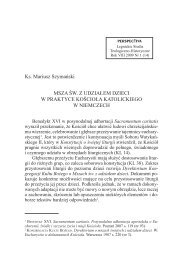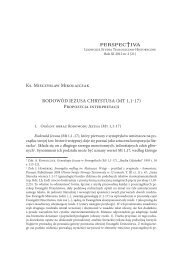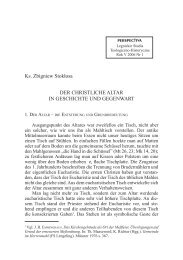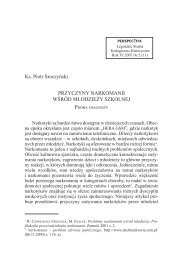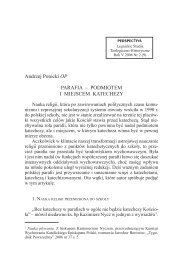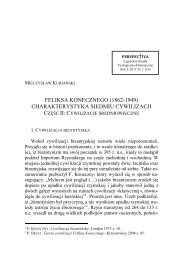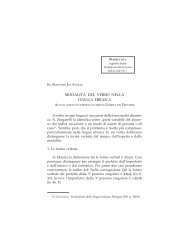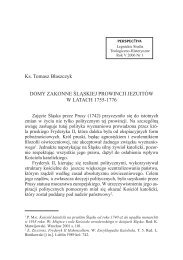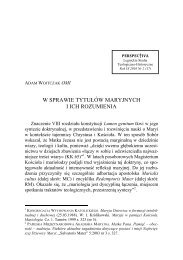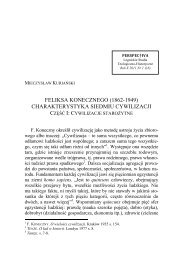STEFAN IAVORSKII AND PROTESTANTISM - Perspectiva
STEFAN IAVORSKII AND PROTESTANTISM - Perspectiva
STEFAN IAVORSKII AND PROTESTANTISM - Perspectiva
You also want an ePaper? Increase the reach of your titles
YUMPU automatically turns print PDFs into web optimized ePapers that Google loves.
ADAM DROZDEK<br />
PERSPEC†IVA<br />
Legnickie Studia<br />
Teologiczno-Historyczne<br />
Rok X 2011 Nr 1 (18)<br />
<strong>STEFAN</strong> <strong>IAVORSKII</strong> <strong>AND</strong> <strong>PROTESTANTISM</strong><br />
Simeon Iavorskii was born in 1658 w Iavor in the western Ukraine.<br />
In 1667, his family moved eastward to settle near Nezhin. Since<br />
1673 he had studied in the Kiev Academy, and beginning in 1684 he<br />
continued his education in Polish universities after converting to the<br />
Uniate faith, when he assumed the name of Stanislav. After his return<br />
to Kiev in 1687 (or 1689), he converted to Orthodoxy, and after two<br />
years, he became a monk and assumed the name of Stefan. Soon after<br />
he started teaching poetics, rhetoric, philosophy, and theology in the<br />
Kiev Academy. In 1691, he became a prefect and professor of philosophy.<br />
In 1697, he became a hegumen, i.e., an abbot of the Holy<br />
Nikolskii monastery. At that time, he wrote poetry in Polish, Latin,<br />
and Russian 1 . In 1700, Peter I heard and appreciated one of his speeches<br />
and soon after made him the metropolitan of Riazan’ and Murom.<br />
He was nominated a protector of the Moscow Slavonic-Greek-Latin<br />
Academy introducing many reforms in it and also in the educational<br />
system in Moscow. After the death of patriarch Adrian in 1700, no<br />
new patriarch was nominated, but Peter I chose Iavorskii to fulfill the<br />
duties of the post. Iavorskii accepted hoping that this was a prelude<br />
for his becoming the next patriarch. Iavorskii advocated many social<br />
1 The little known poetic side of Iavorskii is presented by R. ŁUŻNY. Stefan Jaworski –<br />
poeta nieznany. „Slavia Orientalis” 1967 nr 4 p. 363-376.
Stefan Iavorskii and Protestantism 47<br />
and economic reforms of the tsar but did not agree with the tsar’s<br />
policy toward the church. In a 1712 sermon, he considered the tsarevich<br />
Aleksei to be the only hope of Russia, the son of the tsar who<br />
soon was later arrested for treason and died in prison. After this sermon<br />
Iavorskii was prohibited from having public sermons. In a letter<br />
to the tsar he still tried to defend himself and the independence of the<br />
church, and yet, although reluctantly, he signed the Spiritual Regulation<br />
in 1721 that gave the tsar the authority over the church, and he<br />
was nominated the president of the newly established Most Holy<br />
Synod. However, before and after that act, his influence on the life of<br />
the church steadily waned. He died in 1722.<br />
1. THE ROCK OF FAITH<br />
Iavorskii was known for his oratory skills leaving over 300 unpublished<br />
sermons 2 . He was very well versed in the Bible and in the<br />
writings of the church fathers. He was very traditional in his theological<br />
views which are best expressed in his opus vitae, The Rock of<br />
Faith. The book, written in 1713-1715, and published for the first time<br />
posthumously in 1728, is a defense of the Orthodox church from the<br />
attacks of Protestants. The rock (камень) of faith is Christ who is at<br />
the same time the cornerstone (камень), the stone on which the true<br />
church is based, and the stumbling block (камень), on which all heretics<br />
stumble and their teachings are pulverized (KV preface) 3 .<br />
2 А.И. НИКОЛЬСКИЙ. Описание рукописей, хранящихся в Архиве Святейшего<br />
Правительствующего Синода. Vol. 2. Part 1. Санкт-Петербург 1906 p. 381-426.<br />
3 The following references will be used:<br />
KV – С. ЯВОРСКИЙ. Камень веры православно-кефолическия восточныя Церкви,<br />
святыя сынам на утверждение и духовноя созидание, претыкающимся же<br />
о камень претыкания и соблазна на востание и исправление. Киев 1730.<br />
S – Слова СТЕФАНА ЯВОРСКOГО, митрополита рязанскoго и муромскoго. Труды<br />
Киевской духовной академии 1874. Vol. 3 p. 72-121, Vol. 4 p. 123-154, 505-520;<br />
1875, Vol. 1 p. 118-128, 631-647, Vol. 2 p. 486-505, Vol. 3 p. 463-492, Vol. 4 p.<br />
124-145.<br />
Z – С. ЯВОРСКИЙ. Знамения пришествия антихристова и кончины века, от<br />
писаний Божественных явленна. Москва 1703. In his: Сказание об антихристе.<br />
Догмат о святых иконах. Москва 1999 p. 29-112.
48 ADAM DROZDEK<br />
The Rock of Faith consists of twelve chapters that concentrate on<br />
twelve issues: the icons; the cross; the relics; the Eucharist; prayers<br />
to the saints; prayers of the departed; prayers for the departed; tradition;<br />
liturgy; fasting; good works; and punishment of heretics. The<br />
structure of all chapters is similar. First, the positive teachings of the<br />
Orthodox church concerning a partucular issue are presented – and<br />
this is the part related to the cornerstone; then teachings of Protestants<br />
considered erroneous are refuted – which is the part related to the<br />
stumbing block; and finally some rational arguments are presented<br />
where rationality means deriving certain conclusions from the Biblical<br />
statements. The Rock of Faith is at the same time an apologetic work<br />
and a defense of the only true Christian teaching, which, to be sure,<br />
is for Iavorskii the teaching of the Orthodox church. The author did<br />
not strive for originality; actually, he refrained from it. His originality<br />
may stem primarily from the way he presented his arguments, from<br />
his greater reliance than his predecessors on logic, in particular, syllogistic<br />
reasoning 4 . Some examples he used may also be original. Over<br />
a thousand pages of the book are filled with many Biblical passages<br />
and with many quotations from the church fathers, in particular Greek<br />
fathers, with occasional references to the Latin fathers. The Rock of<br />
Faith belongs to the category of lightweight theology, concentrating<br />
on issues that divide Orthodoxy from Protestantism, which might in<br />
many cases be considered of secondary importance. Sometimes the<br />
discussion is carried to the extreme in bringing up issues of seemingly<br />
no importance at all: was Christ crucified on a four-pointed cross or<br />
on an eight-pointed cross, if the ends of the board with the inscription<br />
and the footrest are also considered integral parts of the cross (KV<br />
249-252). This concern may trivialize theological issues, but, on the<br />
other hand, this issue led to a serious rift within the Russian church<br />
just as did another seemingly unimportant problem, whether people<br />
should cross themselves with two fingers or with three fingers. First<br />
4 І. МОРЕВ. „Камень веры” митрополита Стефана Яворского, его место среди<br />
отечественных противопротестантских сочинений и характеристические<br />
особенности его догматических воззрений. Санкт-Петербург 1904 p. 279. The<br />
Rock of Faith is different from other polemical literature in „the scientific statement<br />
of the problem, [namely] on the level of the needs of the science of the time”. И.И.<br />
СОКОЛОВ. Отношение протестантизма к России в XVI и XVII вв. Москва:<br />
Лисснер и Роман 1880 s. 145.
Stefan Iavorskii and Protestantism 49<br />
principles of Christian faith are taken as givens and not scrutinized in<br />
The Rock of Faith: the nature of God 5 , of the Trinity, proofs of the<br />
existence of God, God’s economy and energies, the nature of the Incarnation<br />
6 , the origin of evil and the theodicy problem, and the like.<br />
2. ICONS<br />
An issue that well illustrates a doctrinal division between the Protestants<br />
and the Orthodox church is the treatment of icons. The Protestants<br />
criticized the Orthodox church for its veneration of icons which<br />
they likened to idolatry. This was far from a new problem, since already<br />
in the past, well before the Protestantism existed, iconoclasm<br />
had been a very strong movement inside the church, even leading to<br />
bloody confrontations (iconoclastic controversy from AD 726 to 843).<br />
The major Orthodox argument in defense of icons is that there is<br />
a difference between the veneration of icons and the worship of God.<br />
Worship (λατρεία) is due only to God (KV 95, 108, 111), whereas<br />
icons are only venerated, which is done not on account of icons, but<br />
on account of what or whom they depict and signify. It is the same<br />
with the veneration of relics (285) and with the OT and NT sacrifices<br />
(791). Icons are thus intermediaries, whereby the venerating of icons<br />
turns into the veneration of the saints and the worship of God. Actually,<br />
any form of veneration is done on account of God, since everything<br />
was created by God and thus veneration is a form of worship of<br />
God (110, 111): in the Bible „honor and bowing is given to inanimate<br />
objects as much as they come from and are related to God Himself”<br />
(15-16). Idols are images of what does not exist – mythological gods<br />
that do not exist. Icons are images of what exists, lives, and what is<br />
holy in itself and thus worthy of honor (4-5, 124).<br />
God did not order making images of Christ, but there is no prohibition<br />
of making His images (KV 5). Also, although making and venerating<br />
icons is not mentioned in the Bible, there are many things not<br />
5 He agreed that God’s nature cannot be exactly determined, but His nature cannot<br />
be expressed in more understandable terms. С. ЯВОРСЬКИЙ. Філософські твори.<br />
Київ: Наукова думка 1992. V. 1 p. 84.<br />
6 A few remarks concerning the unity of two natures in Christ are made at the closing<br />
of the chapter on the Eucharist (443-456).
50 ADAM DROZDEK<br />
mentioned there in which Christians believe, and Iavorskii mentioned<br />
the same essence of God and the Son, which is the doctrine established<br />
by ecumenical councils, and so is the teaching about icons that<br />
comes primarily from tradition (141). The Protestants may not be altogether<br />
convinced by this argument, since they insist on using the Bible<br />
as the only source of Christian dogmas, not on tradition. However, if<br />
not directly, then indirectly the Bible does point to the possibility of<br />
venerating icons. For example, Israelites bowed to the cloudy pillar<br />
when Moses was entering the tent (Ex 33:10); if so, asked rhetorically<br />
Iavorskii, why one should prohibit bowing to and thus venerating<br />
icons? (8).<br />
Veneration of icons is of particularly great benefit for simple<br />
people who cannot read but who surely can look at images of the<br />
suffering Christ, stated Iavorskii. Images of the last judgment and of<br />
hell led the prince Vladimir to accept the Orthodox faith (KV 17,<br />
73). If so, it may appear that the more realistic icons are, the more<br />
strongly they speak to people. However, the tradition of iconography<br />
specifically prohibits realism. Do the stylized images of the suffering<br />
Christ or of hell really have the same power of conviction as very<br />
realistic images of Christ and hell present in Western art? Iavorskii<br />
said that when believers pray before icons, they direct their minds to<br />
the invisible (18). This is where the stylized character of icons may<br />
have more impact: their otherworldly depictions may more easily direct<br />
the mind toward the otherworldly originals than very realistic<br />
depictions could do.<br />
Veneration of icons is confirmed by miracles (KV 41-47). „It is<br />
easier to count stars of the sky, leaves on trees, grass on all the earth,<br />
sand in all seas than to list miracles by icons of Christ, Mother of<br />
God, (…) and the saints of God” (45). True, there are false miracles,<br />
but true miracles are always for the benefit of people. Icons have power<br />
to bring people to the good (46, 135). Also, miracles are needed:<br />
1. for pagans to be converted, 2. to strengthen the Orthodox faith, 3.<br />
to see that people believe in the same Christian church that at its<br />
origins performed miracles, 4. to show the presence of God in His<br />
church, 5. to glorify God, 6. to see that God cares for people (134-<br />
135). Miracles confirm the validity of icons as an objects of veneration,<br />
but the believers must constantly keep in mind that „an icon does<br />
not perform miracles by itself, but God performs miracles in the icon
Stefan Iavorskii and Protestantism 51<br />
or through the icon since only God can perform miracles” (175),<br />
whereby such an icon should elevate the mind toward the true author<br />
of the miracle. However, the Protestants stated that icons can very<br />
easily become more than just objects of veneration – idolatry is a<br />
constant danger. Iavorskii’s response was that only the new in faith<br />
or the weakly rooted can idolize icons, not an Orthodox believer. „For<br />
us, the holy icons are beneficial; but as for you, they [lead] you to<br />
disgrace and eternal perdition” (149), added Iavorskii in an ungainly<br />
comment. Is Iavorskii really convinced that no Orthodox believer can<br />
fall into the snares of idolatrous treatment of icons? He stated that no<br />
distinction should be made between new and old icons and only<br />
„mindless schismatics” believe otherwise (161). That would mean that<br />
an Orthodox believer will not make such a mistake, because, by definition,<br />
he would thereby automatically put himself outside the Orthodox<br />
church. And thus, no Orthodox believer can idolize icons since,<br />
in this way, he would cease to become an Orthodox believer.<br />
Such a solution, however, has an air of sophistry and of merely terminological<br />
explanation.<br />
It is not any different in justifying an honor for other entities. For<br />
example, the Orthodox believe that „honoring relics of the holy saints<br />
of God is an act of piety” (KV 261). The Israelites worshipped a brazen<br />
serpent and a golden calf (283) to the point of idolizing them,<br />
particularly the latter, which indicated that they all too easily were<br />
becoming idolaters. In order to prevent them from worshipping the<br />
body of Moses, its burial place remained hidden from them: God<br />
through an angel buried it so that no one could find it (261, 276, 283).<br />
However, what would be bad for the Israelites is beneficial for Orthodox<br />
believers, „perfect men”, perfect in faith, that is, since they do<br />
not honor relics as gods (283). There is no danger of idolatry among<br />
Orthodox believers (276), simply by definition. However, why remnants<br />
of Joseph that were preserved and then carried to the promised<br />
land (261) were not exposing the Israelites to the danger of idolatry<br />
is not explained.
52 ADAM DROZDEK<br />
3. ESCHATOLOGY<br />
Iavorskii did his best to remain within the limits of the traditional<br />
Orthodox teachings, but there are certain areas which this tradition<br />
does not define very firmly. These include the problem of eschatology,<br />
including the problem of salvation.<br />
Iavorskii was particularly appalled by the Protestant teaching that<br />
faith would be sufficient for salvation. In his mind, the teaching that<br />
we are saved by faith alone means that we can steal, murder, etc. and<br />
be not afraid since faith alone will save us. True, faith saves us, but<br />
faith made alive by good works; otherwise, faith is dead (KV admonition).<br />
He was convinced that the Kingdom of God is not given for<br />
faith alone, without good works: good works along with faith lead to<br />
salvation (903-904). When Paul spoke about salvation without works<br />
of law, he meant pagan works and works under Mosaic law, not works<br />
done in Christ (928). However, even Iavorskii’s contemporary, Prokopovich,<br />
disagreed with the role of good works in salvation by maintaining<br />
that salvation cannot be earned by good works 7 ; good works<br />
can only earn a better reward – since „different levels of glory and<br />
joy are differently measured according to the virtue and works” 8 – but<br />
not the reward itself. However, both views can be reconciled by<br />
viewing faith as the only condition for salvation, but the genuine<br />
character of the faith can be recognized by the life of the person, by<br />
the works which should be the fruit of such faith. In that sense, works<br />
are necessary for salvation since they testify about the existence of<br />
genuine faith. Iavorskii seemed to agree with this when he stated that<br />
our good works are the gift of Christ (940) and that they „stem not<br />
only from faith, but primarily from love for God” (994), i.e., they are<br />
not quite our good works.<br />
The afterlife is divided between heaven and hell. However, residing<br />
in hell does not mean an eternal perdition. Members of the same<br />
body – the church – should care for one another, both for the living<br />
7 Ф. ПРОКОПОВИЧ. Разговор гражданина с селянином да певцем или дячком<br />
церковным. In: П.В. Верховской. Учреждение Духовной коллегии и Духовный<br />
регламент. Ростов-на-Дону 1916 p. 72, 74. Cf. МОРЕВ. „Камень веры”. p. 351.<br />
8 ПРОКОПОВИЧ. Разговор гражданина с селянином. p. 73.
Stefan Iavorskii and Protestantism 53<br />
and for the dead (KV 631). There is one church and it encompasses<br />
the believers on earth and in the afterlife. Therefore, the church should<br />
make an effort to improve the fate of the souls after death. This is<br />
done by the prayer for souls of the dead, by giving alms for them,<br />
and by bringing to God the bloodless sacrifice – the Eucharist – for<br />
them (603). In life, a priest forgives a penitent his sin and gives penance<br />
(613). If the penance is not fulfilled before death, the penitent<br />
must be helped by alms, prayers, and bloodless sacrifice of the living<br />
(614). The penitent who did not manage to make penance is saved<br />
but does not go to heaven. Iavorskii rejected the Catholic teaching<br />
about purgatory as the place for just such souls (660-663) by folding<br />
it into hell: just as there are many mansions in heaven and different<br />
rewards (J 14:2), so there are many different punishments in hell<br />
(667) and for some there is a chance for salvation, and it is the task<br />
of the church to pray for salvation of those in hell. In this way, purgatory<br />
simply becomes a part of hell. Actually, before the Incarnation,<br />
the departed OT saints „did not go to heaven and did not see God”<br />
(471); thus, hell was also their residence. Therefore, when Ezekiel<br />
spoke about Noah, Daniel, and Job, they were not in heaven but<br />
„they were locked in some dark place waiting for the coming of Christ”<br />
(516). However, the saints in the Old and the New Testaments are<br />
in the same place (577; 471). When Christ went to hell after death,<br />
he saved all those who believed in Him, which certainly included the<br />
OT saints.<br />
The Orthodox teaching on the subject of eschatology is not quite<br />
settled. Some fathers said that a repented but not yet forgiven soul<br />
encounters various hurdles on its way to heaven, each hurdle associated<br />
with different sin and on each hurdle angels and demons bargain,<br />
as it were, about the amount of a particular sin in a person,<br />
which ends up either with angels lifting the soul to heaven or demons<br />
dragging it down to hell (KV 663-664). Presumably, there may still<br />
be a chance for some souls to be released from hell if assisted by<br />
prayers of the church. Some fathers teach that there is only heaven and<br />
hell (665-666/71), and some souls in hell are there for good, but<br />
some can be released. Either view is fine, stated Iavorskii, since it is<br />
just an opinion, not a dogma, although Iavorskii himself leaned toward<br />
the first opinion (667/72).
54 ADAM DROZDEK<br />
There are two judgments after death. One judgment takes place<br />
right after death, and so does a reward, if it is deserved (KV 578).<br />
Judgment after death rewards the soul only; the last judgment rewards<br />
both the soul and body (590). This is the time of resurrection,<br />
resurrection of some to eternal life and others to eternal perdition (Z<br />
96-97). They will resurrect in their own bodies which are but dust by<br />
then, but God will put them together. Although in Iavorskii’s view, the<br />
new body will be „of the same nature but with different qualities and<br />
quantities” (100), its nature seems to undergo significant transformation.<br />
The new body will be made immortal and in the blossom of its<br />
development – as a body a of thirty year old person – free of illness<br />
and bodily deficiencies, free from suffering, with no need of nourishment<br />
(although eating [for show?] is possible), able to pass through<br />
matter (98-102). The bodies of the condemned will also be immortal,<br />
but will be „a subject of suffering, cruelly tormented for eternity in<br />
inextinguishable flames” (102). Incidentally, demons suffer already<br />
now (KV 594), but they will suffer to the fullest after the last judgment<br />
(594).<br />
4. THE CHURCH<br />
There are several reasons Iavorskii mentioned why Protestants<br />
have no claim on representing the true church and only the Orthodox<br />
church is the true church. 1. It is old (KV 48). 2. The true church has<br />
no end; it cannot cease to exists and be reestablished; thus, by definition,<br />
Luther and Calvin did not reestablish the church (49, 52, 56-57).<br />
3. The Orthodox church is a true church, although it is not based on<br />
the Bible, alone since the Bible and tradition have the same force just<br />
as „the written word of the king has the same power as his spoken<br />
word” (50). 4. Although there are invisible aspects of the church, the<br />
true church is also visible in the world and thus could not invisibly<br />
exist until Luther (50-51). 5. The Protestant church has many heretical<br />
teachings, and thus cannot be true: it rejects tradition; rejects the true<br />
presence of Christ’s body in the Eucharist; rejects the sacrament of<br />
anointing with oil and repentance; teaches that the church was visible<br />
and then invisible; rejects veneration of icons; rejects prayer for the
Stefan Iavorskii and Protestantism 55<br />
dead; claims that Mary was not a virgin after Christ was born (58-60).<br />
6. The true church stems directly from Christ and the apostles (60).<br />
The second and the fourth arguments are related, and it seems that<br />
only these two arguments have some force in the context of the contrast<br />
between the Orthodoxy and Protestantism, although the Protestants<br />
could argue that what they reestablished was present as a weak<br />
undercurrent in the existing church. They can just as well claim the<br />
provenance of their teachings as originating with Christ and the apostles.<br />
They simply disagree with the role of tradition and did use that as<br />
an indication of perverting the purity of the original Christian teaching.<br />
How can Iavorskii – or any Orthodox teacher – determine that the<br />
Protestants espouse heretical doctrines? This is the problem of the<br />
foundation of the church. On the one hand, Iavorskii defended the<br />
view that the Bible and the tradition form such a foundation: the<br />
Bible transmits teachings in a written form; tradition does that in an<br />
oral form which only later was put on paper (KV 50, 673). The Bible<br />
states that the church is the pillar and ground of truth (1 Tim 3:15),<br />
whereby it cannot hold to erroneous doctrines (675, 681). In general,<br />
„the entire foundation of our faith, the bastion, and an immovable<br />
stone of the spiritual edifice is the true Word of God” (356). In particular,<br />
the Protestant objection that the fathers of the church are not<br />
authoritative since „every man lies”, as the Bible repeatedly states, is<br />
refuted with the statement that a man „as a leader of the church of<br />
Christ and as a teacher possessing true rule and being instructed by<br />
the Holy Spirit (...) cannot lie” (KV 64). Interestingly, Iavorskii did<br />
not apparently notice that his argument can be used in favor of the<br />
doctrine of the papal infallibility, which is the stumbling block for the<br />
Orthodox believers. He also stated that the Orthodox church has a<br />
teaching about the prayer for the dead; „can the Holy, Ecumenical and<br />
Apostolic Church include anything in its general institutions and<br />
laws that is contrary to orthodox faith?” If so, then it would be contrary<br />
to the assurance that the gates of the hell will not prevail against<br />
the church (Mt 16:18) (633, 53). The latter argument, however, can<br />
be appropriated by other branches of Christianity, too, to be used in<br />
support of their doctrines.<br />
On the other hand, the church determines what is the Bible, i.e.,<br />
what are canonical books of the Bible – and there are differences<br />
between he Protestant Bible, the Catholic Bible (which includes deu-
56 ADAM DROZDEK<br />
terocanonical books), and the Orthodox Bible (the Septuagint Bible,<br />
where the OT is translated into Greek, is the foundational text). Moreover,<br />
the church specifies the proper reading of the Bible. Improper<br />
interpretation is made according to „one’s own false understanding,<br />
without any careful testing, without looking at preceding and succeeding<br />
words, without looking at proper interpretation of the holy<br />
fathers – the lights and the pillars of the Church” (KV 494). Proper<br />
interpretation of unclear passages of the Bible comes from tradition<br />
(689, 734) and so does the explanation of apparent contradictions in<br />
the Bible (695). Iavorskii mentioned those who say that some Biblical<br />
passages can be clarified by other Biblical passages (738). This almost<br />
certainly was an allusion to Prokopovich who maintained that the<br />
Bible is clear enough for everyone to understand; the Bible itself can<br />
be used for clarification of passages 9 . This reliance only on the Bible<br />
is, however, an unacceptable Protestant teaching and should be rejected,<br />
according to Iavorskii.<br />
The church also determines what tradition is and what are the<br />
extrabiblical dogmas which should be accepted by believers. „Tradition<br />
is necessary for faith since faith can be based only on tradition<br />
and the Holy Scripture without tradition is insufficient for faith” (KV<br />
677). If the Israelite priests could establish new laws (Deut 17:10-12),<br />
then all the more Orthodox Church can do the same (839). If worldly<br />
rulers can establish new laws, why not allow ecclesiastical leaders to<br />
do the same? (843). Also, Christ said that what Christians bind on<br />
earth will be bound in heaven, where binding is interpreted as establishing<br />
new laws for believers (840). Therefore, the church is really the<br />
starting point of faith if it determines what is the Word of God, what<br />
is the Biblical canon (688-689). In this way, there is an unsettling<br />
problem of circularity: the Bible is what it is because of the decision<br />
of the church; on the other hand, by definition, the church cannot be<br />
mistaken since it is pronounced (more or less explicitly) as inerrant<br />
in the Bible. This important theological problem of circularity with the<br />
church determining the Bible and the Bible determining the church<br />
was, however, not addressed by Iavorskii.<br />
Iavorskii also stated that Luther and Calvin did not perform any<br />
miracle to show legitimacy of their claims (KV 66), and, as for Luther,<br />
9 МОРЕВ. „Камень веры”. p. 365.
Stefan Iavorskii and Protestantism 57<br />
his life was not particularly holy. He broke his monastic vows and<br />
got married to a nun; „even the gallows would be too little for such<br />
lawlessness” (67).<br />
This is the tone which permeates The Rock of Faith. The Protestants<br />
are addressed as enemies, as opponents, as adversaries, not even<br />
as separated brothers. The tone is venomous, ill-spirited, with a disquieting<br />
absence of an expected Christian charity in someone who,<br />
effectively, was the head of the Russian Orthodox church. In that,<br />
Iavorskii followed the footsteps of his predecessors. From the beginning,<br />
Russian theologians considered Lutherans and Calvinists as<br />
heretics, as servants of the antichrist and satan. Starets Artemii was<br />
convinced that their teachings are suited for carnal life, and that they<br />
proclaim the name of Christ only for show. Ivan Nasedka claimed that<br />
they are even worse than Catholics. The Likhud brothers said that<br />
they should not be even considered Christians, and in Nasedka’s opinion,<br />
the Lutheran church is not the church of God but a house of the<br />
devil 10 . Iavorskii joined them with his statement addressed to the<br />
Lutheran church: it is „only a heap of damned heresies and true Babylonian<br />
adulteress that serves pleasures of your flesh, but leading<br />
you along wide and spacious way to perdition” (KV 59). Not surprisingly,<br />
the Protestant accusation that icons are a seduction, meets<br />
with this baneful rebuttal: this „seduction stems from you, not from<br />
us; and perdition awaits not us but you; which is not even worthy of<br />
pity, since the source [of seduction] is not your weakness, but your<br />
malice” (166).<br />
Incidentally, when presenting his arguments in favor of the true<br />
church, Iavorskii concentrated on his polemic with the Protestants.<br />
Catholicism is also a heretical branch of Christianity for the Orthodox;<br />
however, Iavorskii would be very hard pressed to justify this,<br />
since the marks of the true church he listed can be applied to the<br />
Catholic church as well.<br />
10 МОРЕВ. „Камень веры”. p. 3-8.
58 ADAM DROZDEK<br />
5. HERESY IN THE CHURCH<br />
If the church is all-important, if the salvation can be only in the<br />
Orthodox church (Z 39), if this is the only true church, how did it<br />
translate into practical issues of ecclesiastical policy: the Orthodox<br />
church vs. heresies, and the Orthodox church vs. secular rule?<br />
As for heretics who once have been Orthodox, then „for the benefit<br />
of the peaceful building of the church and for the undisturbed peace<br />
of the people, the heretics should be punished” (KV 1028). Iavorskii<br />
used many arguments to justify the punishment of heretics. Here are<br />
some of them. 1. Since a heretic should be a subject of an anathema,<br />
then he can even be put to death, since it is worse to be given up to<br />
satan than to endure any bodily suffering (1032). 2. „The experience<br />
teaches us that there is no other cure for heretics except for death”.<br />
They are not afraid of dispossession, and when they are exiled, they<br />
keep on deceiving others (1032-1033). 3. How come that money counterfeiters<br />
are put do death but not those who falsify church teachings?<br />
(1033) 4. Change of faith is a sin worse than cheating on one’s<br />
wife, and yet the cheater is punished by death (1033). 5. Criminals become<br />
useful for the state after they are executed as a warning to others,<br />
so it should be with heretics (1033). 6. Death is a blessing for the heretics<br />
as well, since it prevents them from becoming more sinful<br />
(1034). It may be actually puzzling why that matters since heretics are<br />
damned, anyway. However, as mentioned, there are different levels<br />
of damnation in hell, and heretics put to death early enough presumably<br />
will suffer in hell less than they would when living a longer life.<br />
7. Christ did not command to kill heretics – only for them to be to the<br />
believers as „a heathen and a publican” (Mt 18:17) – but He also did<br />
not forbid it (1036). He also allowed his disciples to stop following<br />
Him (J 6:66-67), but it does not mean the free rein to every believer,<br />
and Christ found it more properly „not to avenge Himself for insults,<br />
but to leave the vengeance to His spiritual sons” (1038/1075ab, 1042/<br />
1079b). 8. Loving of enemies means loving „your enemies”, presumably,<br />
personal enemies, not the enemies of the church (1039).<br />
In punishing the heretics, the church is concerned about the souls<br />
depraved by heresy and about their salvation (KV 1037, 1040), and the<br />
death sentence is applied only after all other means of conversion have
Stefan Iavorskii and Protestantism 59<br />
been exhausted (1043). Also, although „faith is God’s gift, God dispatches<br />
this gift in variety of ways, one way being punishment” (1043).<br />
Iavorskii’s arguments may not convince many, some of them being<br />
tenuous, some verging on sophistry. Even the Orthodox church viewed<br />
them as too controversial and expressed too crudely since the<br />
chapter on the punishment of heretics was included only the first<br />
printings of The Rock of Faith 11 . Iavorskii, however, was very concerned<br />
about the purity of the Orthodox doctrine and was convinced<br />
that even capital punishment should be used to maintain this purity in<br />
the minds of the believers. If the death of the few scares off the rest<br />
from diverging from ecclesiastical truth – so much the better for the<br />
living. But, in practical terms, who should perform executions? Certainly<br />
not the church, and this brings us to the problem of the churchstate<br />
relationship and the role of Iavorskii, who by the fact of his exalted<br />
position in the church, willingly or otherwise, struggled with finding<br />
a proper balance for this relationship.<br />
6. THE SYNOD<br />
As already mentioned, Peter I did not allow for a new patriarch to<br />
be nominated, making Iavorskii first the patriarch’s stand-in 12 and then<br />
the head of the Holy Synod which was created to make the church a<br />
branch of the government answering to the state, i.e., to the tsar. Iavorskii<br />
was not accidentally called to these posts. Over the years, in<br />
his sermons, he acclaimed Peter I’s economic, cultural and educational<br />
policies, extolling him in lofty language, comparing him to just any<br />
important Biblical figure, so that he was, for example, the Russian<br />
Noah (S 1875.1.118), Moses (1875.4.129, 131-132, 143), David<br />
(1875.4.149-150, 152), and Samson (1875.3.476). Effectively, the tsar<br />
was also compared to Christ being, along with Christ, a cornerstone<br />
of Russia (1874.4.141-142). He was addressed thus: „O stone given<br />
from above, from heavenly mountain! O stone that gloriously crushed<br />
11 МОРЕВ. „Камень веры”. p. 298.<br />
12 He was not even that; he was „sort of an officer of the tsar for sacramental affairs”.<br />
В. ЖИВОВ. Из церковной истории времен Петра Великого: исследования<br />
и материалы. Москва: Новое литературное обозрение 2004 s. 123.
60 ADAM DROZDEK<br />
the iron legs of an idol! Who can glorify your firmness the way it<br />
deserves, your strength, your force, your love to your people? (…)<br />
[Peter,] the arch-courageous warrior acting magnanimously and ready<br />
to give his life for his people” (1875.3.488). Iavorskii commiserated<br />
with the tsar by pointing to the heavy cross the tsar has to carry: „he<br />
has to have constant and incessant care for his empire, to protect all<br />
his subjects from attacks of enemies, to listen to everyone, to be just<br />
to everyone, to defend everyone from offenders; on top of it, to listen<br />
to ill-spirited grumbling of some ingrates” (KV 257). Iavorskii actually<br />
found references to tsars in the Bible. The woman clothed in the<br />
sun with the moon under her feet (Rev 12:1) is „our Orthodox, Eastern<br />
Church”, and the two eagle wings on which she flew (12:14) are<br />
unmistakably the sign of the Russian tsars, the defenders of the<br />
church (S 1874.3.86). Peter I, who conquered the seven-headed Swedish<br />
snake is also referred to in a prophecy as a rider who brings<br />
salvation (Hab 3:8) (S 1874.3.94-95). Arguably, the main reason for<br />
Iavorskii to have authored his 1703 book about the antichrist was a<br />
defense of the tsar. One Grigorii Talitskii was spreading a heresy that<br />
Peter I was the antichrist and Moscow was Babylon (25). For Iavorskii,<br />
it was, of course, unacceptable, but acceptable was the view that<br />
the antichrist would be a Jew of a courtesan mother (53, 66) and that<br />
Rome would be Babylon (89).<br />
In this adulation, Iavorskii was not unlike another major figure of<br />
the age, Prokopovich, who theologically justified pretty much anything<br />
Peter I fancied to have done. However, at least on one point<br />
there was a disagreement between them: Prokopovich promoted subjugation<br />
of the church to the state and was a driving force behind The<br />
spiritual regulation that led to the establishment of the Holy Synod.<br />
Iavorskii, on the other hand, did not abandon the belief that the church<br />
should be independent from the state, just at it was the case with the<br />
church in Russia in the past and is the case with the Catholic church<br />
in the West. He agreed that the rule of the tsar was of divine origin 13 ,<br />
but he rejected the possibility of the secular rule to have a say in eccle-<br />
13 KV 82; Cf. Iavorskii’s note „this is true” on a margin of Piotr Skarga’s book when<br />
Skarga stated that the Caesar „has his Empire from God Himself”. G.B. BERCOFF.<br />
Stefan Jaworski a historia. Na podstawie dopisków na marginesach jego książek. In<br />
Corona scientiarum: studia z historii literatury i kultury nowożytnej ofiarowane<br />
profesorowi Januszowi Pelcowi. Warszawa: Neriton 2004 p. 389.
Stefan Iavorskii and Protestantism 61<br />
siastical matters since „ecclesiastical structure and boundaries and regulations<br />
of the ecclesiastical order as being a matter of faith God<br />
handed in to the Apostles and their successors” (KV 82). True, some<br />
ecclesiastical rules originated with emperors (e.g., Constantine and<br />
Justinian), but they were related to „civic trials and to building the<br />
well-being of the church, but not to articles of faith” and, Iavorskii<br />
assured the reader that policies of Peter I were no different (83). „We<br />
are always obligated to submit ourselves to the tsar in civic matters.<br />
In matters related to faith – to the highest pastor”. Tsars rule over people<br />
in matters related to the body, not to the soul; the spiritual authority<br />
is related to the latter, although, as Iavorskii added, „the spiritual<br />
authority is concerned about life and satisfaction both in the<br />
body and in the soul. (…) In fact, tsars are protectors of laws of God<br />
and of the church, but do not define them” (84). He quoted approvingly<br />
the words of Theodore the Studite directed to the iconoclastic<br />
emperor Leo V the Armenian: „Sire, it is not for you to scrutinize and<br />
nullify ecclesiastical commands. To your rule belong earthly affairs,<br />
ecclesiastical affairs belong to priests and teachers of the church and<br />
to you it is commanded to follow and subdue yourself to them” (102).<br />
Iavorskii believed that „the holy church has both spiritual and secular<br />
leaders, like two hands, so it has two swords, spiritual and material,<br />
one useful for another. Thus, when the spiritual sword has little success,<br />
the material sword should be used” (1038).<br />
In his desire for an independent church, Iavorskii represented a<br />
conservative party of the church which was fairly strong. In order to<br />
prevent a complete alienation of this party from his tsarist policies,<br />
Peter I co-opted Iavorskii to the Synod, although Prokopovich seems<br />
to have been a more obvious candidate 14 . However, in practical terms,<br />
it did not matter since very soon Iavorskii became just a figurehead,<br />
and many – most – decisions were made without him, possibly with<br />
his rubberstamping them. He was weak and ill and yet by making him<br />
a nominal head of the synod, Peter I pacified many conservatives in<br />
the church. The fact that he was – as both Iavorskii and Prokopovich<br />
both agreed – divinely appointed was used by Peter I to the extreme.<br />
And, arguably, he stayed away from the doctrinal matters of the<br />
14 Cf. Ю.Ф. САМАРИН. Стефан Яворский и Феофан Прокопович. In his:<br />
Сочинения. Москва: Мамонтов 1880. Vol. 5 p. 300.
62 ADAM DROZDEK<br />
church and thus, on the surface, he fit Iavorskii’s vision of a ruler. But<br />
was Iavorskii satisfied?<br />
A case can be made that, of course, The Rock of Faith was a religious<br />
treatise, an apology of Orthodoxy and a polemic with Protestantism<br />
and with heretical tendencies in Russia, but implicitly it was<br />
also a polemic with the tsar and with the type of religiosity the tsar<br />
espoused, which was Orthodoxy leaning toward Protestantism 15 . This<br />
was also a vision of Orthodoxy advocated by Prokopovich 16 . In that<br />
sense, such open and severe criticism of Protestantism was a bold<br />
move on the part of Iavorskii 17 . In this way, Iavorskii reciprocated in<br />
kind to Prokopovich and the tsar. They frequently criticized the papacy,<br />
which really was a thinly veiled criticism of the Orthodox patriarchy.<br />
They did it not only in word, but also in deed. The tsar crudely<br />
mocked the papacy with drunkards dressed as the pope and cardinals,<br />
and he even explicitly mocked the patriarchy with his most<br />
drunken council 18 . In that sense, The Rock of Faith is not only a religious<br />
statement, but also a political statement. Iavorskii, although he<br />
reached the heights in the hierarchy of the church, did not perform<br />
very well as a politician, and the loss of independence of the church<br />
under his watch certainly testifies to this. Although meeker in form,<br />
The Rock of Faith does speak about his opposition to the arrogance<br />
of the state and the tsar in respect to making the church a department<br />
of the government.<br />
15 The book „was in reality directed against Peter” rather than against Protestantism,<br />
according Iurij Ńerech, Stefan Yavorsky and the conflict of ideologies in the age of<br />
Peter I. „Slavonic and East European Review” 30:1951 p. 57. The view is contested<br />
by J. CRACRAFT. The Church reform of Peter the Great. Stanford University Press<br />
1971 p. 131, on account of the fact that the tsar was ready to give his imprimatur in<br />
the preface. However, the fact that the tsar did not see the book as a slight against<br />
him does not mean that it may not have been so intended by Iavorskii. Also, the tsar<br />
simply may not have considered the book as a serious threat to himself.<br />
16 Prokopovich was even accused of Protestant heresy, in which accusation Iavorskii<br />
participated, but the tsar ignored it and the whole affair ended with rather humiliating<br />
Iavorskii’s recantation of the accusation and apology given to Prokopovich. П.<br />
МОРОЗОВ. Феофан Прокопович как писатель. Санкт-Петербург: Балашев 1880<br />
p. 188, 192.<br />
17 САМАРИН. Стефан Яворский. p. 265.<br />
18 CRACRAFT. The Church reform. p. 11-13.
Stefan Iavorskii and Protestantism 63<br />
<strong>STEFAN</strong> JAWORSKI I PROTESTANTYZM<br />
S t r e s z c z e n i e<br />
Stefan Jaworski, biskup-metropolita riazański, jest tragiczną postacią w<br />
historii Kościoła rosyjskiego. W odróżnieniu od Prokopowicza, niezwykle<br />
ważną sprawą dla niego była niezależność Kościoła od władzy państwowej,<br />
a mimo to został prezydentem Świętego Synodu, który stanowił organ władzy<br />
cara Piotra I nad Kościołem. Jaworski był znanym oratorem, poetą, świetnie<br />
wykształconym człowiekiem. Dziełem jego życia jest Skała wiary, monumentalne<br />
dzieło stawiające sobie za zadanie odparcie ataków protestantów<br />
na wiele elementów doktryny Kościoła prawosławnego. W artykule pokrótce<br />
omawia się jego obronę ikon. Jaworski nie próbował wprowadzać oryginalnych<br />
interpretacji doktryn prawosławnych, starał się być jak najbardziej ortodoksyjny<br />
w tym względzie, lecz nie wszystko zostało jednoznacznie ustalone<br />
w tych doktrynach. Jedną z takich dziedzin jest eschatologia i artykuł prezentuje<br />
poglądy Jaworskiego na kwestię życia po śmierci. Skała wiary była<br />
wielokrotnie wznawiana, lecz wprowadzano często do niej zmiany, odrzucając<br />
pewne partie i dodając inne. Jedną z kontrowersyjnych części był ostatni<br />
rozdział omawiający herezję i rozdział ten jest pokrótce przedstawiony w<br />
artykule. W sumie Skałę wiary uważać można nie tylko za krytykę protestantyzmu,<br />
lecz, przynajmniej do pewnego stopnia, niejawną krytykę Piotra I<br />
i Prokopowicza, których uważano za wprowadzających protestanckie elementy<br />
do Kościoła prawosławnego.<br />
Słowa kluczowe: Kościół prawosławny, protestantyzm, eschatologia, ikony.<br />
Keywords: Orthodox Church, Protestantism, eschatology, icons.



